IGUANAS
 Iguana ble |  Dan rezo Iguana |
|---|---|
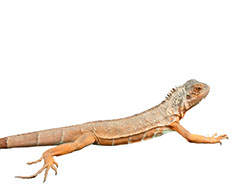 Iguana wouj | 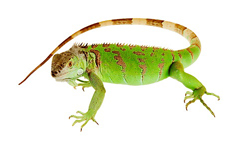 Iguana vèt |
Iguana swen dra
Gwosè: Iguanas granmoun ranje nan grandè sòti de kat pou sis pye nan ki bagay.
Kap dire: Si byen pran swen vèv yo, iguanas ta dwe rete plis ke 20 ane an kaptivite.
Jeneral jan moun parèt: Iguanas se sa pifò moun panse a lè yo panse ke zandolit.\' Yo gen senk zòtèy nan chak pye. Yo genyen yon grasèt à po anba bab a te rele yon dewlap. Tout iguanas gen Dos kouri sou do longè tan. Ale kont popilè yo kwè sa, pa tout iguanas ki vèt. Pifò jeunes ki klere vèt, men jan yo laj yo devlope yo ka ranje nan koulè sòti de yon ti vèt pou maron ou menm zoranj ak ke par.
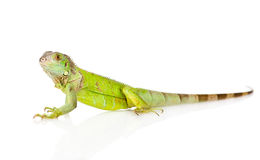
Kondisyon lojman
Ladann: Ladann pou yon granmoun iguana trè laj. Ladann a ta dwe omwen sis pye wotè, apepwè 1½ pou de fwa sou longè tan iguana a, ak 2\\/3 yonn pou tout kantite lajè iguana. Pou yon pye sis granmoun iguana, se sa yon ladann sa se 9 12 pye de longè, kat ak sis pye lajè, ak omwen sis pye wotè. Sifizan branch li yo ak libweri Eskalad yo ak lounging yo dwe bay. Pou yo fè ou konprann sou mezi a ladann, anpil ti chanm akouche yo se sèlman 9 pye lajè. Se poutèt sa, mèt anpil consacrer yon chanm separe tankou \'iguana chanm yo.\' Kèk pwopwiyetè tou pèmèt yo iguanas pou \'gratis de batay la atravè kay la. Si ou pèmèt ou iguana pou viv nan pwòp sal, ni pòte lib, pou se konsa a kenbe zòn nan òdinè iguana a ap bay libète nan ti atik ki gen valè sa a iguana ka a aza\\/chans ale.
Tanperati: Iguanas ki soti nan yon klima tropical epi ou bezwen pou l \' rete cho. Journée tanperati yo ta dwe 80° - 85° F ak kote se yon de 90° - 95° F. Ta dwe gen yon de tanperati ki te ofri pou iguana pou pèmèt li pou thermoregulate tèt li. Tanperati ankò ta dwe 75° - 80° F. Tout tanperati ta dwe fè l fèt pou l avèk yon tèmomèt regilyèman.
Chalè\\/limyè: Radyasyon ekleraj bay UVA ak UVB mande pou kalsyòm onèt du ak devlòpman skèlèt. Pa bon mache ou va vin malad vin ak yon mouri ki fè lapenn anpil. Konvnab ekleraj kapab bay utilisant Fluoresan ti tiyo nou espesyalman te fè pou sèvi ak pa reptiles kòm mèji ampoules\\/voye lafimen sa ki bay yon chalè a tou. Chalè lòt ka bay utilisant émetteurs en envizib detèktè yo ak à se ampoules. Wòch cho ta dwe pa janm sèvi anba yon sikonstans sa yo ka yon malè sou boule ou iguana.

Substrate: Iguanas a souvan lang lick ozalantou yo. Poutèt sa ki pi particules substrate (bwa copeaux, paillis, grenn sab, oswa poud tip) ki pa apwopriye pou pifò iguanas. Jounal ak lank ki pa anpwazonnen, papye bouche a, papye sèvyèt, UN anndan\\/an, oubyen atifisyèl zèb tout fè pou m chwazi trè byen. Si w ap itilize UN anndan\\/an oswa atifisyèl zèb souple, asire ke genyen pa fisèl toute sa te kapab enchevêtrement nan pikèt ou iguana. Li anmenmtan ou gen plizyè mòso pou nou ka ranplase tout mòso sale ak sèvis Bondye a ansanm ak lè sa a fè sèvis ezenfekte aktyèl ansanm pou yo itilize pou moun kap vini netwaye.
Environment: Iguanas come from a tropical climate and require a humidity level of 65% to 75%. To achieve this may require several misting’s a day. Many people opt to purchase an automatic misting system instead.
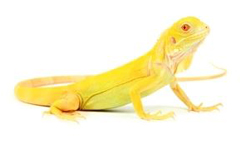
Diet: Iguanas are strict herbivores. Many older literatures will suggest feeding animal protein or even cat food. While some wild iguanas may ingest the occasional insect while eating leaves, it is not a significant portion on their diet. Iguanas that are fed too much animal protein will develop health problems and will die prematurely. A well balanced iguana diet will consist of about 40% to 45% greens (this includes, but is not limited to collard greens, turnip greens, mustard greens, dandelion greens (with flowers), escarole, and/or water cress), 40% to 45% other vegetables (this includes but is not limited to green beans, orange-fleshed squashes (butternut, Kabocha), snap or snow peas, parsnip, asparagus, okra, alfalfa (mature, not sprouts), onions, mushrooms, bell peppers, sweet potato, zucchini, yellow squash, and/or carrots), 10% or less of fruits (including, but not limited to Figs (raw or dried), blackberries, strawberries, raspberries, grapes, mango, melon (cantaloupe, honeydew, watermelon), papaya, banana, and/or apple), and less than 5% of other grains or commercial diets. Iguanas should never be rhubarb as it is toxic. Certain lettuces such as iceberg, romaine, and Boston butter lack sufficient nutrients and should only be fed occasionally. Acidic fruits (citrus, tomatoes, kiwi, pineapples, etc.) should also be only fed occasionally as well. Tofu can be occasionally offered as well for supplemental protein, though if too much is given it can lead to long term health issues. Wild plants and flowers are not recommended since they may be toxic to your iguana or may contain pesticides that could be toxic as well.
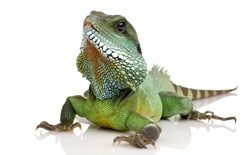
Maintenance: Cleanliness of the enclosure is essential. Waste products should be removed daily and the enclosure should be thoroughly cleaned and disinfected regularly. A 5% bleach solution provides an excellent disinfectant. Be sure to thoroughly rinse the solution from the enclosure before placing the iguana back in. Fresh water should also be offered at all times. Always wash your hands after handling your iguana or any of your iguana\'s cage accessories.